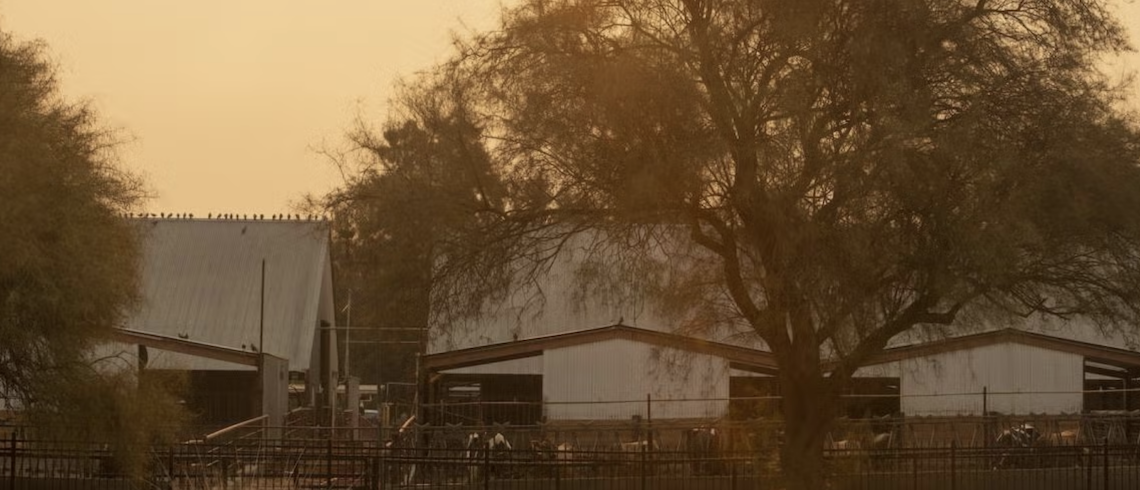
Smoke from a 2020 wildfire over a livestock barn for dairy cattle on the UC Davis campus. (Gregory Urquiaga / UC Davis)
Millions of cell tower pings from dating, weather, messaging and other mobile apps that use location-sharing services are helping agricultural economists better understand how farmworkers respond to environmental hazards such as wildfire smoke.
During California’s most destructive wildfire season in 2020, the number of farmworkers in a surveyed field fell by nearly 35% and the number of hours worked in that same location dropped by 37% on smoky days when elevated levels of particulate matter were in the air.
On less smoky days, the number of workers in surveyed fields was nearly 18% below typical levels and the hours worked were 23% below normal, according to novel research from the University of California, Davis, to be published in the January edition of Journal of the Association of Environmental and Resource Economists.
“When this smoke is really heavy there’s a large reduction in the amount of people in a field in day,” said Tim Beatty, chair of the Department of Agricultural and Resource Economics and the senior author on the research.
The researchers also found that farmworkers tended to work more hours in the days leading up to smoke events and switched fields to avoid the worst conditions.
“We could figure out very rich hourly information of where these farmworkers went and if they moved to another location,” said Goeun Lee, a postdoctoral scholar and lead author on the journal paper. “This is kind of the first application of this data to answer some important questions in agricultural economics.”
A new resource
The research represents a new way of gleaning information about one of California’s most elusive workforces — farmworkers who harvest crops that help feed the nation — that conventional sources cannot quantify.
“The results are relevant for policy makers seeking to protect workers health, safety and well-being and to ensure the sustainability of one of the most productive agricultural regions in the world,” the authors wrote.
Lee and Beatty used crop field boundaries to define agricultural crop locations, overlayed smoke plume and weather data to determine environmental conditions and accessed cell phone data from a company that collects location information from about 400 mobile applications.
They identified time, place and movement data of cell phones at the field level from January to mid-October for 12,667 crop workers — representing 8% of the agricultural workforce in California — and a sample size 20 times that of the federal National Agricultural Worker Survey of 2020, which is a main but limited point-in-time resource for tracking this population.
“We don’t do a good job of collecting data on these pretty marginalized groups who are very important, so it’s very hard for us to say anything about policies that affect them because they don’t turn up in the data,” Beatty said. “This mobility data is interesting and important to really answer questions about a group of people who are underrepresented in surveys.”
Shocks on the horizon
Major wildfires and other environmental shocks are projected to become more frequent and current protections may not be adequate to protect farmworkers and their financial health, the authors said.
“Farmworkers primarily work outdoors and they’re exposed to many environmental shocks and factors that can affect their health and productivity negatively,” Lee said. “Climate change is expected to increase the frequency of wildfire smoke and California relies a lot on this labor force. They are essential for California agriculture.”
Wildfire smoke can cause fatigue, dizziness, headaches, confusion and other symptoms that increase the risk of injury. The researchers defined high smoke days as those with 40 micrograms per cubic meter of particulate matter. California regulations require workers to wear protective gear like respirators, alter their schedule or work in an area with better air quality when particulate matter is 55.5 micrograms per cubic meter.
The short harvest season coincides with more intense wildfire months, which means farmworkers could lose wages while avoiding smoke hazards. “We should worry about people’s health but also their ability to earn a living because that also impacts their health and wellbeing quite directly,” Beatty said.
Future studies
The research has some limitations related to who made decisions related to smoke.
“It could be as simple as farmers have multiple fields and they just switch the field they’re harvesting that day. It could be they work for a farm labor contractor and they just basically change the client they are working for that day,” Beatty said. “That sets the table for a lot of future questions.”
The methodology could be used to answer future labor, environmental and agricultural economics questions and the authors are using cell phone data to track farmworker movement and behavior during extreme heat events and after pesticide use.
“This kind of new data set that we made can be a valuable resource to answer other questions about farmworkers,” Lee said.
The research was funded by the USDA National Institute of Food and Agriculture.







